

Compact Muon Solenoid
LHC, CERN
| CMS-B2G-18-006 ; CERN-EP-2019-110 | ||
| Combination of CMS searches for heavy resonances decaying to pairs of bosons or leptons | ||
| CMS Collaboration | ||
| 31 May 2019 | ||
| Phys. Lett. B 798 (2019) 134952 | ||
| Abstract: A statistical combination of searches for heavy resonances decaying to pairs of bosons or leptons is presented. The data correspond to an integrated luminosity of 35.9 fb$^{-1}$ collected during 2016 by the CMS experiment at the LHC in proton-proton collisions at a center-of-mass energy of 13 TeV. The data are found to be consistent with expectations from the standard model background. Exclusion limits are set in the context of models of spin-1 heavy vector triplets and of spin-2 bulk gravitons. For mass-degenerate W' and Z' resonances that predominantly couple to the standard model gauge bosons, the mass exclusion at 95% confidence level of heavy vector bosons is extended to 4.5 TeV as compared to 3.8 TeV determined from the best individual channel. This excluded mass increases to 5.0 TeV if the resonances couple predominantly to fermions. | ||
| Links: e-print arXiv:1906.00057 [hep-ex] (PDF) ; CDS record ; inSPIRE record ; HepData record ; CADI line (restricted) ; | ||
| Figures & Tables | Summary | Additional Figures | References | CMS Publications |
|---|
| Figures | |
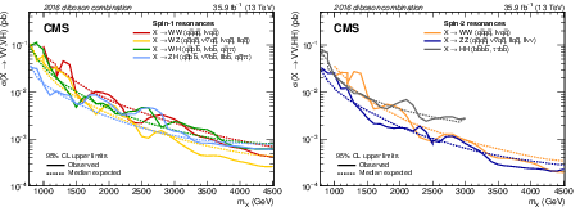
png pdf |
Figure 1:
Observed and expected 95% CL upper limits on the product of the cross section and branching fraction of a spin-1 (left) or spin-2 resonance (right) decaying to a pair of SM bosons. |

png pdf |
Figure 1-a:
Observed and expected 95% CL upper limits on the product of the cross section and branching fraction of a spin-1 resonance decaying to a pair of SM bosons. |
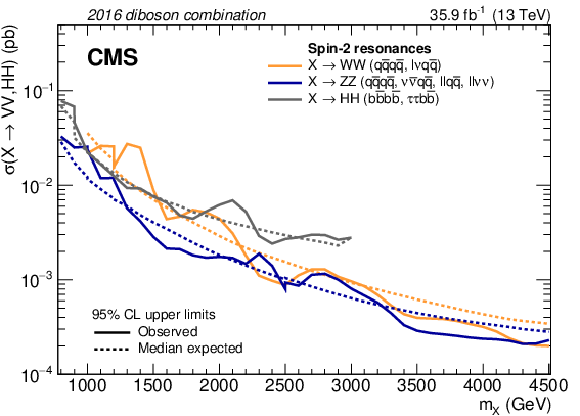
png pdf |
Figure 1-b:
Observed and expected 95% CL upper limits on the product of the cross section and branching fraction of a spin-2 resonance decaying to a pair of SM bosons. |
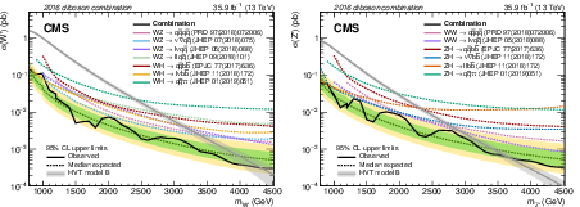
png pdf |
Figure 2:
Observed and expected 95% CL upper limits on the W' (left) and Z' cross section (right) as a function of the W' and Z' resonance mass. The inner green and outer yellow bands represent the ${\pm}$1 and ${\pm}$2 standard deviation variations on the expected limits of the statistical combination of the VV and VH channels considered. The expected limits in individual channels are represented by the colored dashed lines. The solid curves surrounded by the shaded areas show the cross sections predicted by the HVT model B and their uncertainties. |

png pdf |
Figure 2-a:
Observed and expected 95% CL upper limits on the W' cross section as a function of the resonance mass. The inner green and outer yellow bands represent the ${\pm}$1 and ${\pm}$2 standard deviation variations on the expected limits of the statistical combination of the VV and VH channels considered. The expected limits in individual channels are represented by the colored dashed lines. The solid curves surrounded by the shaded areas show the cross sections predicted by the HVT model B and their uncertainties. |
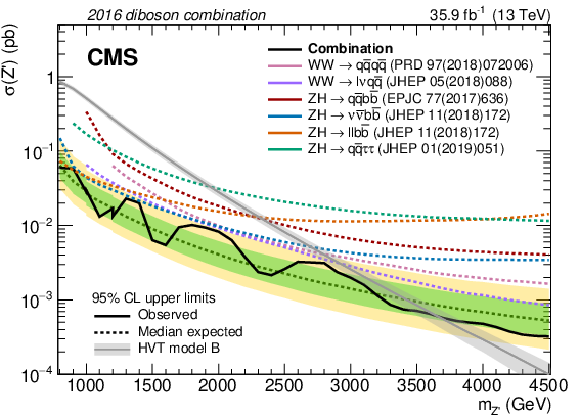
png pdf |
Figure 2-b:
Observed and expected 95% CL upper limits on the Z' cross section as a function of the resonance mass. The inner green and outer yellow bands represent the ${\pm}$1 and ${\pm}$2 standard deviation variations on the expected limits of the statistical combination of the VV and VH channels considered. The expected limits in individual channels are represented by the colored dashed lines. The solid curves surrounded by the shaded areas show the cross sections predicted by the HVT model B and their uncertainties. |
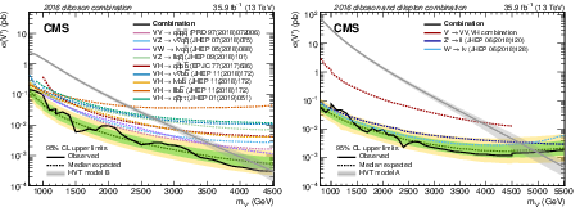
png pdf |
Figure 3:
Observed and expected 95% CL upper limits on cross sections as a function of the HVT triplet mass for the combination of all channels in the HVT model B (left) and model A (right). The inner green and outer yellow bands represent the ${\pm}$1 and ${\pm}$2 standard deviation variations on the expected limit. The solid curves surrounded by the shaded areas show the cross sections predicted by HVT models A and B and their uncertainties. |
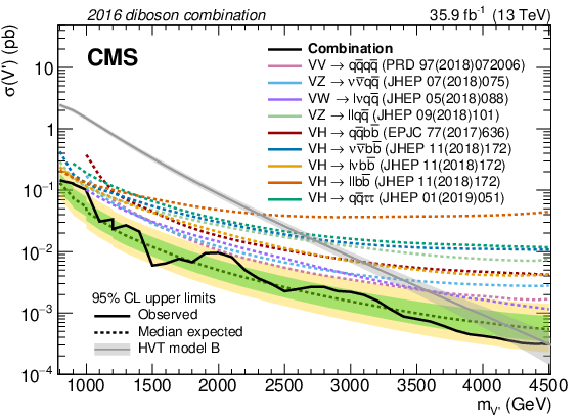
png pdf |
Figure 3-a:
Observed and expected 95% CL upper limits on cross sections as a function of the HVT triplet mass for the combination of all channels in the HVT model B. The inner green and outer yellow bands represent the ${\pm}$1 and ${\pm}$2 standard deviation variations on the expected limit. The solid curves surrounded by the shaded areas show the cross sections predicted by the HVT model with uncertainties. |

png pdf |
Figure 3-b:
Observed and expected 95% CL upper limits on cross sections as a function of the HVT triplet mass for the combination of all channels in the HVT model A. The inner green and outer yellow bands represent the ${\pm}$1 and ${\pm}$2 standard deviation variations on the expected limit. The solid curves surrounded by the shaded areas show the cross sections predicted by the HVT model with uncertainties. |

png pdf |
Figure 4:
Observed exclusion limits on the couplings of heavy vector resonances to fermions and SM vector bosons and the Higgs boson for the statistical combination (solid lines) of the dilepton (dotted lines) and diboson channels (dashed lines). Three resonance masses hypotheses (3.0, 4.0, and 4.5 TeV) are considered. The hatched bands indicate the regions excluded. The areas bounded by the thin gray contour lines correspond to regions where the resonance widths ($\Gamma _{\mathrm{V}'}$) are predicted to be larger than the average experimental resolution (5%). |

png pdf |
Figure 5:
Observed and expected 95% CL upper limit on the cross section of the spin-2 bulk graviton as a function of its mass for the statistical combination of the WW, ZZ, and HH channels. The inner green and outer yellow bands represent the ${\pm}$1 and ${\pm}$2 standard deviation variations on the expected limit. The solid curve and its shaded area represent the cross section derived with the parameter $ {\hat{\kappa}} =$ 0.5 and the associated uncertainty. |
| Tables | |

png pdf |
Table 1:
Summary of the main selections that guarantee the exclusivity between individual final states. The symbol $\ell $ represents an electron or a muon; $\tau $ leptons are considered separately. The AK4 b jets are additional b tagged AK4 jets that do not geometrically overlap with AK8 jets. The symbol "--'' implies that no selection is applied. |
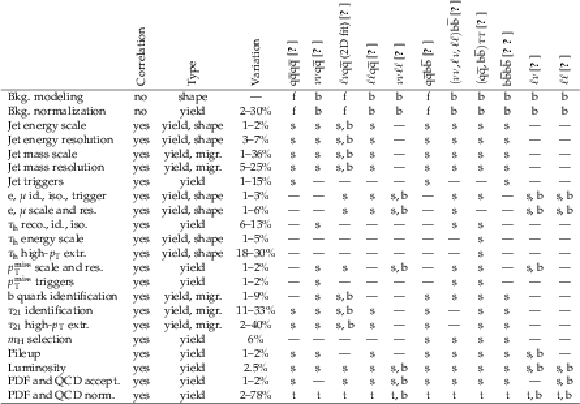
png pdf |
Table 2:
Summary of the main systematic uncertainties. The second column reports whether a systematic uncertainty is considered fully correlated or not across different channels. The third column indicates whether the uncertainty affects the yield, the shape of the distributions, or both, or if it induces migration (migr.) effects across search regions. The fourth column reports the smallest and largest effect of the uncertainty in either the yield or the signal shape parameters. The symbols "s'', "b'' indicate that the uncertainty affects the signal, the main backgrounds of the analysis, respectively. The treatment of non-dominant backgrounds is often different and not reported here. The symbol "f'' indicates that the parameters are not constrained, or associated with large uncertainties as in the case of multi-dimensional fits. The entries labeled with "t'' are treated differently depending on the interpretation of the exclusion limit, as discussed in Section 7. Uncertainties marked with "--'' are not applicable or are negligible. |
| Summary |
| A statistical combination of searches for heavy resonances decaying into pairs of vector bosons, a vector boson and a Higgs boson, two Higgs bosons, or pairs of leptons, has been presented. The results are based on data collected by the CMS experiment at $\sqrt{s} = $ 13 TeV during 2016 corresponding to an integrated luminosity of 35.9 fb$^{-1}$. In models with warped extra dimensions, upper limits of up to 1.1 fb are set at 95% confidence level on the production cross section of the spin-2 bulk graviton. For models with a triplet of narrow spin-1 resonances, heavy vector bosons with masses below 5.0 and 4.5 TeV are excluded at 95% confidence level in models where the W' and Z' bosons couple predominantly to fermions and bosons, respectively. In the latter, the statistical combination extends the exclusion limit by 700 GeV as compared to the best individual channel. |
| Additional Figures | |

png pdf |
Additional Figure 2:
Observed and expected 95% CL upper limits on the product of the bulk graviton cross section and the $\text {G}\to {\mathrm {W}} {\mathrm {W}}$ branching fraction as a function of the G resonance mass. The inner green and outer yellow bands represent the ${\pm}$1 and ${\pm}$2 standard deviation variations on the expected limits of the statistical combination of the resonant WW channels. The expected limits in individual channels are represented by the colored dashed lines. |
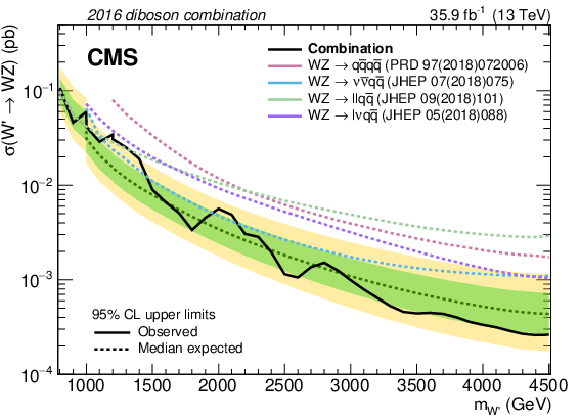
png pdf |
Additional Figure 3:
Observed and expected 95% CL upper limits on the product of the W' cross section and the $ {\mathrm {W}'} \to {\mathrm {W}} {\mathrm {Z}} $ branching fraction as a function of the W' resonance mass. The inner green and outer yellow bands represent the ${\pm}$1 and ${\pm}$2 standard deviation variations on the expected limits of the statistical combination of the resonant WZ channels. The expected limits in individual channels are represented by the colored dashed lines. |
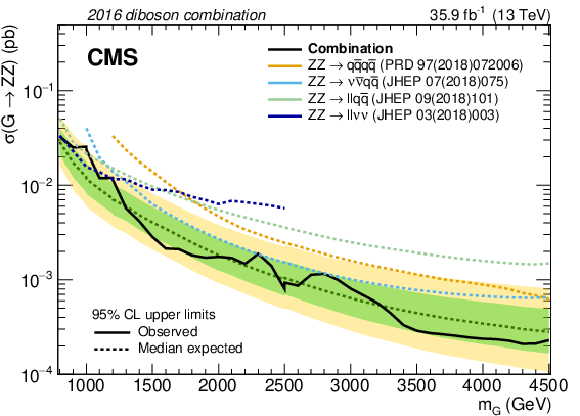
png pdf |
Additional Figure 4:
Observed and expected 95% CL upper limits on the product of the bulk graviton cross section and the $\text {G}\to {\mathrm {Z}} {\mathrm {Z}} $ branching fraction as a function of the G resonance mass. The inner green and outer yellow bands represent the ${\pm}$1 and ${\pm}$2 standard deviation variations on the expected limits of the statistical combination of the resonant ZZ channels. The expected limits in individual channels are represented by the colored dashed lines. |

png pdf |
Additional Figure 5:
Observed and expected 95% CL upper limits on the product of the W' cross section and the $ {\mathrm {W}'} \to {\mathrm {W}} {\mathrm {H}} $ branching fraction as a function of the W' resonance mass. The inner green and outer yellow bands represent the ${\pm}$1 and ${\pm}$2 standard deviation variations on the expected limits of the statistical combination of the resonant WH channels. The expected limits in individual channels are represented by the colored dashed lines. |

png pdf |
Additional Figure 6:
Observed and expected 95% CL upper limits on the product of the Z' cross section and the $ {\mathrm {Z}'} \to {\mathrm {Z}} {\mathrm {H}} $ branching fraction as a function of the Z' resonance mass. The inner green and outer yellow bands represent the ${\pm}$1 and ${\pm}$2 standard deviation variations on the expected limits of the statistical combination of the resonant $ {\mathrm {Z}} {\mathrm {H}} $ channels. The expected limits in individual channels are represented by the colored dashed lines. |

png pdf |
Additional Figure 7:
Observed and expected 95% CL upper limits on the product of the bulk graviton cross section and the $\text {G}\to {\mathrm {H}} {\mathrm {H}} $ branching fraction as a function of the G resonance mass. The inner green and outer yellow bands represent the ${\pm}$1 and ${\pm}$2 standard deviation variations on the expected limits of the statistical combination of the resonant $ {\mathrm {H}} {\mathrm {H}} $ channels. The expected limits in individual channels are represented by the colored dashed lines. |
| References | ||||
| 1 | CMS Collaboration | Search for massive resonances decaying into $ WW $, $ WZ $, $ ZZ $, $ qW $, and $ qZ $ with dijet final states at $ \sqrt{s}=13\text{}\text{}\mathrm{TeV} $ | PRD 97 (2018) 072006 | CMS-B2G-17-001 1708.05379 |
| 2 | CMS Collaboration | Search for a heavy resonance decaying into a Z boson and a vector boson in the $ \nu \overline{\nu}\mathrm{q}\overline{\mathrm{q}} $ final state | JHEP 07 (2018) 075 | CMS-B2G-17-005 1803.03838 |
| 3 | CMS Collaboration | Search for a heavy resonance decaying to a pair of vector bosons in the lepton plus merged jet final state at $ \sqrt{s}= $ 13 TeV | JHEP 05 (2018) 088 | CMS-B2G-16-029 1802.09407 |
| 4 | CMS Collaboration | Search for a heavy resonance decaying into a Z boson and a Z or W boson in 2$ \ell $2q final states at $ \sqrt{s}= $ 13 TeV | JHEP 09 (2018) 101 | CMS-B2G-17-013 1803.10093 |
| 5 | CMS Collaboration | Search for ZZ resonances in the 2$ \ell 2 \nu $ final state in proton-proton collisions at 13 TeV | JHEP 03 (2018) 003 | CMS-B2G-16-023 1711.04370 |
| 6 | CMS Collaboration | Search for heavy resonances that decay into a vector boson and a Higgs boson in hadronic final states at $ \sqrt{s} = $ 13 TeV | EPJC 77 (2017) 636 | CMS-B2G-17-002 1707.01303 |
| 7 | CMS Collaboration | Search for heavy resonances decaying into a vector boson and a Higgs boson in final states with charged leptons, neutrinos and b quarks at $ \sqrt{s}= $ 13 TeV | JHEP 11 (2018) 172 | CMS-B2G-17-004 1807.02826 |
| 8 | CMS Collaboration | Search for heavy resonances decaying into two Higgs bosons or into a Higgs boson and a W or Z boson in proton-proton collisions at 13 TeV | JHEP 01 (2019) 051 | CMS-B2G-17-006 1808.01365 |
| 9 | CMS Collaboration | Search for a massive resonance decaying to a pair of Higgs bosons in the four b quark final state in proton-proton collisions at $ \sqrt{s}= $ 13 TeV | PLB 781 (2018) 244 | 1710.04960 |
| 10 | CMS Collaboration | Search for production of Higgs boson pairs in the four b quark final state using large-area jets in proton-proton collisions at $ \sqrt{s}= $ 13 TeV | JHEP 01 (2019) 040 | CMS-B2G-17-019 1808.01473 |
| 11 | ATLAS Collaboration | Search for diboson resonances with boson-tagged jets in $ pp $ collisions at $ \sqrt{s}= $ 13 TeV with the ATLAS detector | PLB 777 (2018) 91 | 1708.04445 |
| 12 | ATLAS Collaboration | Search for $ WW/WZ $ resonance production in $ \ell \nu qq $ final states in $ pp $ collisions at $ \sqrt{s} = $ 13 TeV with the ATLAS detector | JHEP 03 (2018) 042 | 1710.07235 |
| 13 | ATLAS Collaboration | Searches for heavy $ ZZ $ and $ ZW $ resonances in the $ \ell\ell qq $ and $ \nu\nu qq $ final states in $ pp $ collisions at $ \sqrt{s}= $ 13 TeV with the ATLAS detector | JHEP 03 (2018) 009 | 1708.09638 |
| 14 | ATLAS Collaboration | Search for heavy resonances decaying into $ WW $ in the $ e\nu\mu\nu $ final state in $ pp $ collisions at $ \sqrt{s}= $ 13 TeV with the ATLAS detector | EPJC 78 (2018) 24 | 1710.01123 |
| 15 | ATLAS Collaboration | Search for resonant $ WZ $ production in the fully leptonic final state in proton-proton collisions at $ \sqrt{s} = $ 13 TeV with the ATLAS detector | PLB 787 (2018) 68 | 1806.01532 |
| 16 | ATLAS Collaboration | Search for heavy ZZ resonances in the $ \ell ^+\ell ^-\ell ^+\ell ^- $ and $ \ell ^+\ell ^-\nu \bar{\nu} $ final states using proton-proton collisions at $ \sqrt{s}= $ 13 TeV with the ATLAS detector | EPJC 78 (2018) 293 | 1712.06386 |
| 17 | ATLAS Collaboration | Search for heavy resonances decaying to a $ W $ or $ Z $ boson and a Higgs boson in the $ q\bar{q}^{(\prime)}b\bar{b} $ final state in $ pp $ collisions at $ \sqrt{s} = $ 13 TeV with the ATLAS detector | PLB 774 (2017) 494 | 1707.06958 |
| 18 | ATLAS Collaboration | Search for heavy resonances decaying into a $ W $ or $ Z $ boson and a Higgs boson in final states with leptons and $ b $-jets in 36 fb$ ^{-1} $ of $ \sqrt s = 13 TeV pp $ collisions with the ATLAS detector | JHEP 03 (2018) 174 | 1712.06518 |
| 19 | CMS Collaboration | Search for high-mass resonances in final states with a lepton and missing transverse momentum at $ \sqrt{s}= $ 13 TeV | JHEP 06 (2018) 128 | CMS-EXO-16-033 1803.11133 |
| 20 | CMS Collaboration | Search for high-mass resonances in dilepton final states in proton-proton collisions at $ \sqrt{s}= $ 13 TeV | JHEP 06 (2018) 120 | CMS-EXO-16-047 1803.06292 |
| 21 | ATLAS Collaboration | Search for a new heavy gauge boson resonance decaying into a lepton and missing transverse momentum in 36 fb$ ^{-1} $ of $ pp $ collisions at $ \sqrt{s} = $ 13 TeV with the ATLAS experiment | EPJC 78 (2018) 401 | 1706.04786 |
| 22 | ATLAS Collaboration | Search for new high-mass phenomena in the dilepton final state using 36 fb$ ^{-1} $ of proton-proton collision data at $ \sqrt{s}= $ 13 TeV with the ATLAS detector | JHEP 10 (2017) 182 | 1707.02424 |
| 23 | CMS Collaboration | Search for narrow and broad dijet resonances in proton-proton collisions at $ \sqrt{s}= $ 13 TeV and constraints on dark matter mediators and other new particles | JHEP 08 (2018) 130 | CMS-EXO-16-056 1806.00843 |
| 24 | ATLAS Collaboration | Search for new phenomena in dijet events using 37 fb$ ^{-1} $ of $ pp $ collision data collected at $ \sqrt{s}= $ 13 TeV with the ATLAS detector | PRD 96 (2017) 052004 | 1703.09127 |
| 25 | CMS Collaboration | Search for resonant $ \mathrm{t}\overline{\mathrm{t}} $ production in proton-proton collisions at $ \sqrt{s}= $ 13 TeV | JHEP 04 (2019) 031 | CMS-B2G-17-017 1810.05905 |
| 26 | CMS Collaboration | Search for heavy resonances decaying to a top quark and a bottom quark in the lepton+jets final state in proton-proton collisions at 13 TeV | PLB 777 (2018) 39 | CMS-B2G-17-010 1708.08539 |
| 27 | ATLAS Collaboration | Search for resonances in the mass distribution of jet pairs with one or two jets identified as $ b $-jets in proton-proton collisions at $ \sqrt{s}= $ 13 TeV with the ATLAS detector | PRD 98 (2018) 032016 | 1805.09299 |
| 28 | ATLAS Collaboration | Search for heavy particles decaying into top-quark pairs using lepton-plus-jets events in proton-proton collisions at $ \sqrt{s} = $ 13 TeV with the ATLAS detector | EPJC 78 (2018) 565 | 1804.10823 |
| 29 | ATLAS Collaboration | Search for $ W' \rightarrow tb $ decays in the hadronic final state using pp collisions at $ \sqrt{s}= $ 13 TeV with the ATLAS detector | PLB 781 (2018) 327 | 1801.07893 |
| 30 | C. Grojean, E. Salvioni, and R. Torre | A weakly constrained W$ ' $ at the early LHC | JHEP 07 (2011) 002 | 1103.2761 |
| 31 | V. D. Barger, W.-Y. Keung, and E. Ma | A gauge model with light $ W $ and $ Z $ bosons | PRD 22 (1980) 727 | |
| 32 | E. Salvioni, G. Villadoro, and F. Zwirner | Minimal Z' models: present bounds and early LHC reach | JHEP 09 (2009) 068 | 0909.1320 |
| 33 | R. Contino, D. Pappadopulo, D. Marzocca, and R. Rattazzi | On the effect of resonances in composite Higgs phenomenology | JHEP 10 (2011) 081 | 1109.1570 |
| 34 | D. Marzocca, M. Serone, and J. Shu | General composite Higgs models | JHEP 08 (2012) 13 | 1205.0770 |
| 35 | B. Bellazzini, C. Csaki, and J. Serra | Composite Higgses | EPJC 74 (2014) 2766 | 1401.2457 |
| 36 | K. Lane and L. Pritchett | The light composite Higgs boson in strong extended technicolor | JHEP 06 (2017) 140 | 1604.07085 |
| 37 | T. Han, H. E. Logan, B. McElrath, and L.-T. Wang | Phenomenology of the little Higgs model | PRD 67 (2003) 095004 | hep-ph/0301040 |
| 38 | M. Schmaltz and D. Tucker-Smith | Little Higgs theories | Ann. Rev. Nucl. Part. Sci. 55 (2005) 229 | hep-ph/0502182 |
| 39 | M. Perelstein | Little Higgs models and their phenomenology | Prog. Part. NP 58 (2007) 247 | hep-ph/0512128 |
| 40 | L. Randall and R. Sundrum | A large mass hierarchy from a small extra dimension | PRL 83 (1999) 3370 | hep-ph/9905221 |
| 41 | L. Randall and R. Sundrum | An alternative to compactification | PRL 83 (1999) 4690 | hep-th/9906064 |
| 42 | K. Agashe, H. Davoudiasl, G. Perez, and A. Soni | Warped gravitons at the LHC and beyond | PRD 76 (2007) 036006 | hep-ph/0701186 |
| 43 | A. L. Fitzpatrick, J. Kaplan, L. Randall, and L.-T. Wang | Searching for the Kaluza-Klein graviton in bulk RS models | JHEP 09 (2007) 013 | hep-ph/0701150 |
| 44 | T. Dorigo | Hadron collider searches for diboson resonances | Prog. Part. NP 100 (2018) 211 | 1802.00354 |
| 45 | ATLAS Collaboration | Combination of searches for heavy resonances decaying into bosonic and leptonic final states using 36 fb$ ^{-1} $ of proton-proton collision data at $ \sqrt{s} = $ 13 TeV with the ATLAS detector | PRD 98 (2018) 052008 | 1808.02380 |
| 46 | CMS Collaboration | The CMS experiment at the CERN LHC | JINST 3 (2008) S08004 | CMS-00-001 |
| 47 | CMS Collaboration | Particle-flow reconstruction and global event description with the CMS detector | JINST 12 (2017) P10003 | CMS-PRF-14-001 1706.04965 |
| 48 | CMS Collaboration | Performance of electron reconstruction and selection with the CMS detector in proton-proton collisions at $ \sqrt{s} = $ 8 TeV | JINST 10 (2015) P06005 | CMS-EGM-13-001 1502.02701 |
| 49 | CMS Collaboration | Performance of the CMS muon detector and muon reconstruction with proton-proton collisions at $ \sqrt{s} = $ 13 TeV | JINST 13 (2018) P06015 | CMS-MUO-16-001 1804.04528 |
| 50 | CMS Collaboration | Reconstruction and identification of $ \tau $ lepton decays to hadrons and $ \nu_\tau $ at CMS | JINST 11 (2016) P01019 | CMS-TAU-14-001 1510.07488 |
| 51 | M. Cacciari, G. P. Salam, and G. Soyez | The anti-$ k_\text{t} $ jet clustering algorithm | JHEP 04 (2008) 063 | 0802.1189 |
| 52 | M. Cacciari, G. P. Salam, and G. Soyez | FastJet user manual | EPJC 72 (2012) 1896 | 1111.6097 |
| 53 | M. Cacciari, G. P. Salam, and G. Soyez | The catchment area of jets | JHEP 04 (2008) 005 | 0802.1188 |
| 54 | CMS Collaboration | Pileup removal algorithms | CMS-PAS-JME-14-001 | CMS-PAS-JME-14-001 |
| 55 | CMS Collaboration | Jet energy scale and resolution in the CMS experiment in pp collisions at 8 TeV | JINST 12 (2017) P02014 | CMS-JME-13-004 1607.03663 |
| 56 | CMS Collaboration | Performance of missing transverse momentum in pp collisions at sqrt(s)=13 TeV using the CMS detector | CMS-PAS-JME-17-001 | CMS-PAS-JME-17-001 |
| 57 | D. Bertolini, P. Harris, M. Low, and N. Tran | Pileup per particle identification | JHEP 10 (2014) 59 | 1407.6013 |
| 58 | M. Dasgupta, A. Fregoso, S. Marzani, and G. P. Salam | Towards an understanding of jet substructure | JHEP 09 (2013) 029 | 1307.0007 |
| 59 | A. J. Larkoski, S. Marzani, G. Soyez, and J. Thaler | Soft drop | JHEP 05 (2014) 146 | 1402.2657 |
| 60 | CMS Collaboration | Jet algorithms performance in 13 TeV data | CMS-PAS-JME-16-003 | CMS-PAS-JME-16-003 |
| 61 | J. Thaler and K. Van Tilburg | Identifying boosted objects with N-subjettiness | JHEP 03 (2011) 015 | 1011.2268 |
| 62 | CMS Collaboration | Identification techniques for highly boosted W bosons that decay into hadrons | JHEP 12 (2014) 017 | CMS-JME-13-006 1410.4227 |
| 63 | CMS Collaboration | Identification of heavy-flavour jets with the CMS detector in pp collisions at 13 TeV | JINST 13 (2018) P05011 | CMS-BTV-16-002 1712.07158 |
| 64 | J. Alwall et al. | The automated computation of tree-level and next-to-leading order differential cross sections, and their matching to parton shower simulations | JHEP 07 (2014) 079 | 1405.0301 |
| 65 | J. de Blas, J. M. Lizana, and M. Perez-Victoria | Combining searches of Z' and W' bosons | JHEP 01 (2013) 166 | 1211.2229 |
| 66 | D. Pappadopulo, A. Thamm, R. Torre, and A. Wulzer | Heavy vector triplets: bridging theory and data | JHEP 09 (2014) 60 | 1402.4431 |
| 67 | W. D. Goldberger and M. B. Wise | Modulus stabilization with bulk fields | PRL 83 (1999) 4922 | hep-ph/9907447 |
| 68 | NNPDF Collaboration | Parton distributions for the LHC Run II | JHEP 04 (2015) 040 | 1410.8849 |
| 69 | T. Sjostrand et al. | An introduction to PYTHIA 8.2 | CPC 191 (2015) 159 | 1410.3012 |
| 70 | J. Alwall et al. | Comparative study of various algorithms for the merging of parton showers and matrix elements in hadronic collisions | EPJC 53 (2008) 473 | 0706.2569 |
| 71 | GEANT4 Collaboration | GEANT4---a simulation toolkit | NIMA 506 (2003) 250 | |
| 72 | L. Bianchini et al. | Reconstruction of the Higgs mass in events with Higgs bosons decaying into a pair of $ \tau $ leptons using matrix element techniques | NIMA 862 (2017) 54 | 1603.05910 |
| 73 | CMS Collaboration | Measurement of the inelastic proton-proton cross section at $ \sqrt{s}= $ 13 TeV | JHEP 07 (2018) 161 | CMS-FSQ-15-005 1802.02613 |
| 74 | CMS Collaboration | CMS luminosity measurement for the 2016 data taking period | CDS | |
| 75 | J. Butterworth et al. | PDF4LHC recommendations for LHC Run II | JPG 43 (2016) 23001 | 1510.03865 |
| 76 | T. Junk | Confidence level computation for combining searches with small statistics | NIMA 434 (1999) 435 | hep-ex/9902006 |
| 77 | A. L. Read | Presentation of search results: the $ CL_s $ technique | JPG 28 (2002) 2693 | |
| 78 | CMS and ATLAS Collaborations | Procedure for the LHC Higgs boson search combination in Summer 2011 | CMS-NOTE-2011-005 | |
| 79 | G. Cowan, K. Cranmer, E. Gross, and O. Vitells | Asymptotic formulae for likelihood-based tests of new physics | EPJC 71 (2011) 1554 | 1007.1727 |
| 80 | E. Gross and O. Vitells | Trial factors for the look elsewhere effect in high energy physics | EPJC 70 (2010) 525 | 1005.1891 |
| 81 | CMS Collaboration | Combination of searches for heavy resonances decaying to WW, WZ, ZZ, WH, and ZH boson pairs in proton-proton collisions at $ \sqrt{s}= $ 8 and 13 TeV | PLB 774 (2017) 533 | CMS-B2G-16-007 1705.09171 |

|
Compact Muon Solenoid LHC, CERN |

|

|

|

|

|

|